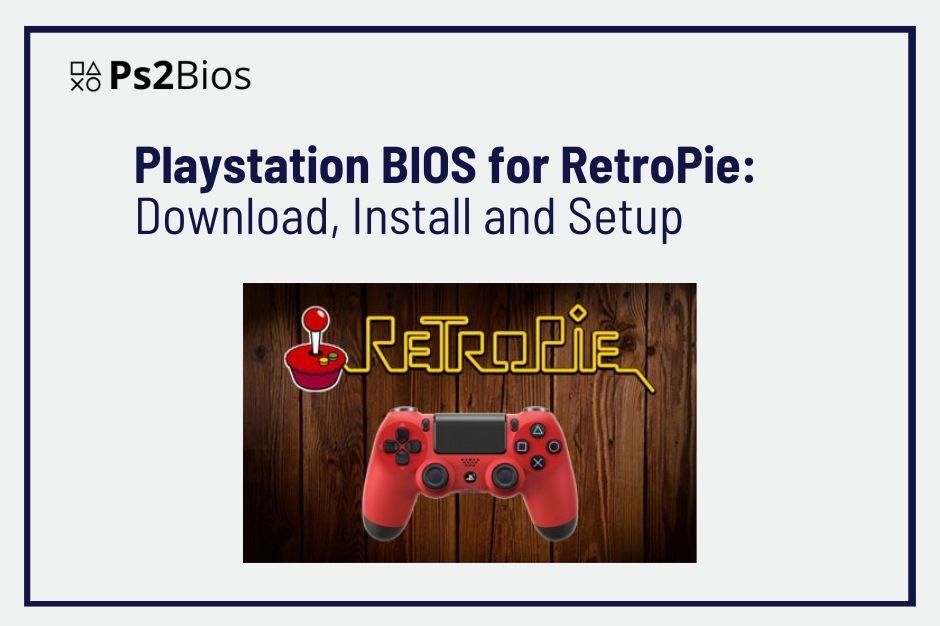RetroPie is a powerful software package that transforms a Raspberry Pi into a versatile gaming console emulator. By utilizing emulation tools like RetroArch, RetroPie allows you to play games from various classic systems, including PlayStation. One of the essential components for running PlayStation games on RetroPie is the PlayStation BIOS file, which provides the necessary system initialization for accurate game emulation. In this guide, we will explore the importance of the PlayStation BIOS for RetroPie, covering topics such as downloading, installing, and setting it up. We’ll also address common installation errors, how to troubleshoot BIOS issues, and how to play PlayStation 1, 2, and 3 games on RetroPie. Finally, we’ll compare RetroPie and RetroArch, helping you understand the differences and optimize your gaming setup for the best experience.
What is RetroPie?
RetroPie is a software package that allows you to emulate old-school gaming consoles on a Raspberry Pi. The entity of RetroPie is the platform, and its attribute is that it enables users to run retro games on a variety of systems. The value lies in its ability to integrate emulation software such as RetroArch, enabling users to play games from systems such as the PlayStation 1 and 2. RetroPie simplifies the process of transforming your Raspberry Pi into a comprehensive gaming console emulator, making it accessible to both seasoned gamers and beginners. As we proceed to explore PlayStation BIOS files in RetroPie, understanding how it operates with these files becomes crucial.
Why is a PS2 BIOS file essential for RetroPie?
The PS2 BIOS file is vital for running PlayStation 2 games on RetroPie. The entity is the PlayStation 2 BIOS, and its attribute is that it contains the necessary instructions and configuration for the console’s hardware. The value is that this file enables RetroPie to run PS2 games accurately, providing the correct system environment for game execution. Without the PS2 BIOS, RetroPie would be unable to emulate PlayStation 2 games, as the BIOS is required to properly initialize the system hardware, including the CPU and memory configuration. This leads us to explore where you can legally obtain the PS2 BIOS file for RetroPie, an essential next step for setup.
Where can you legally obtain PlayStation BIOS files for RetroPie?
Legally obtaining PlayStation BIOS files for RetroPie is essential to ensure compliance with copyright laws. The entity involved here is the source of the BIOS files, and the attribute is the need to acquire these files from authorized or legitimate channels. The value of this is ensuring the authenticity and legal usage of the files. The PS2 BIOS can often be legally obtained if you own the original hardware. Additionally, resources like the RetroPie forums or user communities may offer guidance on the process of obtaining the BIOS files in a way that complies with legal standards. Moving forward, understanding how RetroPie handles these BIOS files will be key to the installation process.
How does RetroPie handle PlayStation BIOS?
RetroPie handles PlayStation BIOS files by utilizing them as part of the system’s emulation process. The entity is RetroPie, and its attribute is its use of BIOS files to simulate the PlayStation system architecture. The value is that RetroPie leverages these files to enable accurate emulation of PlayStation games. When a user adds a PS2 BIOS file to RetroPie, the platform reads it to configure the emulation environment and properly initialize the gaming console’s hardware settings. With that, let’s now look at why the PlayStation BIOS is so important for RetroPie.
Why is the PlayStation BIOS important for RetroPie?
The PlayStation BIOS file is crucial because it acts as the interface between the hardware and the software. The entity is the PlayStation BIOS file, and the attribute is that it contains system initialization code that configures the gaming environment for emulation. The value of this is the accurate replication of the original PlayStation experience on the RetroPie platform. Without the BIOS, many games will fail to run or will not run properly. This leads us into the next section about downloading the PlayStation BIOS for RetroPie.
How to Download PlayStation BIOS for RetroPie?
To download the PlayStation BIOS for RetroPie, the entity is the process of downloading, and the attribute is the need to acquire the file from a reliable and legal source. The value lies in obtaining the correct version of the BIOS that is compatible with RetroPie. Users should download BIOS files from legitimate sources or dump their own from the PlayStation hardware they own. Once you have the BIOS file, you can transfer it to the correct directory in RetroPie. This completes the first step in setting up the PlayStation emulator on RetroPie. We will now discuss the different versions of the PlayStation BIOS supported by RetroPie.
What are the different PlayStation BIOS versions supported by RetroPie?
RetroPie supports several versions of the PlayStation BIOS depending on the model of PlayStation you wish to emulate. The entity is the PlayStation BIOS versions, and the attribute is their compatibility with different models such as the PS1, PS2, and so forth. The value of this is ensuring that users select the correct BIOS for optimal emulation. Versions such as SCPH-1001, SCPH-7502, and others are commonly used for PS1, while for PS2, different BIOS versions like SCPH-39001 are supported. Let’s dive deeper into where you can legally download these BIOS files.
Where can I legally download the PlayStation BIOS for RetroPie?
As mentioned before, ensuring the legal acquisition of BIOS files is crucial. The entity here is the legal sources for downloading, and the attribute is that only authorized platforms or personal backups should be used. The value is maintaining legality in your retro gaming setup. You can download BIOS files from websites that provide them legally, such as from original PlayStation hardware you own or from communities that ensure compliance with copyright law. Now that we’ve covered downloading the BIOS, let’s move on to how to install the BIOS on RetroPie.
How to Install PlayStation BIOS for RetroPie?
Installing the PlayStation BIOS on RetroPie involves placing the BIOS file in the correct directory of your RetroPie system. The entity is RetroPie, and the attribute is its capability to accept and integrate BIOS files into its system. The value is that this allows RetroPie to emulate PlayStation games. Once downloaded, you can place the BIOS files in the /home/pi/RetroPie/BIOS directory. After that, you’ll need to restart RetroPie and configure the system to recognize the BIOS files. This step will enable you to play PlayStation games on your Raspberry Pi. Next, let’s explore some common errors users face when installing the PlayStation BIOS.
What are Common Errors When Installing PlayStation BIOS in RetroPie?
Common errors during the BIOS installation process may include incorrectly placed files, missing BIOS versions, or file permission issues. The entity is the installation process, and the attribute is the potential errors that may arise. The value is resolving these errors to ensure successful installation. Errors such as the BIOS not being recognized or games failing to load are often due to incorrect file placement or corrupt files. Fixing these issues involves double-checking file locations, ensuring the BIOS is compatible, and troubleshooting permission errors. Once these errors are resolved, RetroPie should function as expected.
How to Setup the PlayStation BIOS for RetroPie?
To set up the PlayStation BIOS in RetroPie, you must first download and install the BIOS file, as previously discussed. The entity is RetroPie, and the attribute is the setup process for the BIOS file. The value is the successful configuration of the system for playing PlayStation games. After installing the BIOS, you may need to adjust certain settings within RetroPie, such as enabling the PlayStation emulator and selecting the correct BIOS version. This step-by-step process ensures that RetroPie functions optimally for PlayStation game emulation.
What PlayStation Games Can I Play on RetroPie?
RetroPie supports a wide range of PlayStation games, from the classic PS1 titles to more advanced PS2 games. The entity is PlayStation games, and the attribute is their compatibility with RetroPie. The value is the broad catalog of games available for emulation, including popular titles like Final Fantasy VII and Gran Turismo. This allows RetroPie users to relive their favorite gaming experiences from the PlayStation console. Let’s discuss whether RetroPie can handle PlayStation 1, 2, and 3 games.
Can RetroPie Run PlayStation 1, 2, and 3 Games?
RetroPie is capable of running PlayStation 1 and 2 games but has limitations when it comes to PlayStation 3 games. The entity is RetroPie, and its attribute is the support for PlayStation 1 and 2 emulation. The value is that while RetroPie can emulate games from these consoles, PlayStation 3 games are more challenging to emulate due to their higher processing power requirements. To play PS3 games, a more powerful platform like RPCS3 is recommended. We’ll now cover how to troubleshoot BIOS errors in RetroPie.
How to troubleshoot BIOS errors in RetroPie?
Troubleshooting BIOS errors in RetroPie can involve checking the BIOS file for corruption, ensuring it is placed in the correct directory, and verifying file permissions. The entity here is the troubleshooting process, and the attribute is the errors users may encounter. The value is ensuring smooth gameplay on RetroPie. Common solutions include re-downloading the BIOS file, checking RetroPie’s file path settings, and ensuring all necessary configurations are set. Once these issues are resolved, RetroPie should run without BIOS-related errors. Next, we will discuss how to update the PlayStation BIOS in RetroPie.
How to update the PlayStation BIOS in RetroPie?
Updating the PlayStation BIOS in RetroPie involves downloading a newer version of the BIOS file and replacing the old one. The entity is the PlayStation BIOS, and the attribute is the update process. The value is improving the overall performance and compatibility of RetroPie. To update, simply download the latest BIOS version and replace the old file in the /home/pi/RetroPie/BIOS directory. Afterward, restart RetroPie, and the updated BIOS will be used for PlayStation game emulation. Finally, let’s examine the difference between RetroPie and RetroArch.
What is the Difference Between RetroPie and RetroArch?
RetroPie and RetroArch are both emulation platforms, but they serve slightly different purposes. The entity is RetroPie, and the attribute is its focus on the Raspberry Pi platform, while RetroArch is a multi-platform emulator that supports many systems beyond RetroPie’s reach. The value of RetroPie is its dedicated Raspberry Pi support, while RetroArch excels in cross-platform compatibility. RetroPie integrates RetroArch to provide a more comprehensive emulation experience for various gaming systems, including PlayStation. Thus, understanding the roles of both can help users maximize their gaming setup.


